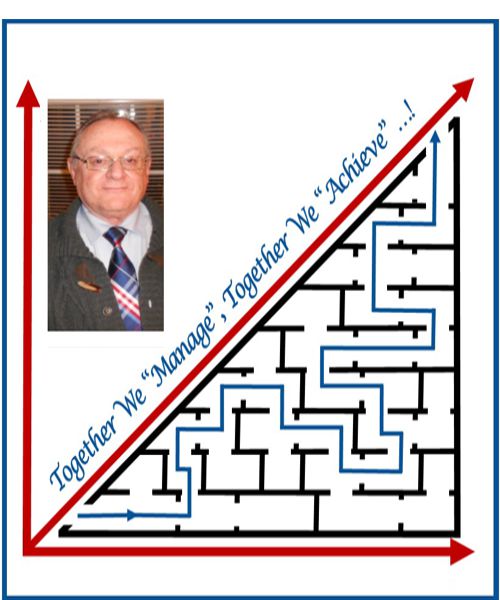Viewpoint
» On "Teaching"
» On "Learning"
» On "Knowledge"
» On "Goals"
» On "Time"
» On “Management”
» On “Reading”
» On "Committees"
» On "A Place to Visit"
» On "Human Resources"
» On "Progress & Development"
» On "History"
» On "Public Speaking"
» On "Organizing"
» On "Motivation"
» On "Teams"
» On "Communication"
» On "Management Coaching"
» On "Traveling"


On "Communication"
By Adel J. Helou
To communicate is to be able to express one’s idea in a way that can be transmitted to others in order for them to understand that idea. Communication is an important and indispensable activity that should be mastered to be successful in life – both socially and professionally.
Early human societies had to communicate to ensure the survival of the species. They could have communicated with one another through signs and sounds. The signs and sounds would be used to signal danger, relief, hunger, thirst, moods, feelings, objects, etc. Early humans also discovered the ability to draw pictures which were used to depict objects, animals, plants, as well as places. Then humans discovered their voices; their ability to make specific, controlled but different sounds with various intonations. The above eventually led to the invention and development of language, drawing and writing.
With the progress of human society over time the elements of good communication were now identifies:
| Thoughts: | Ideas, Concepts, Wishes, Needs, Preferences, Commands, etc. |
| Signals: | Facial Expressions, Hand Movements, Body Posturing, etc. |
| Language: | Speaking, Singing, Poetry, Voice Intonations, etc. |
| Writing: | Vocabulary, Grammar, Punctuations, Calligraphy, etc. |
| Pictures: | Graphics, Maps, Signs, Graphs, etc. |
In our modern times the above five elements of communication have been enhanced and developed due to the developments in the fields of; language, photography, mass media, management, education and technology. Presently, communicating information takes place, mainly through the spoken word. It also takes place visually as in reading book, newspapers and magazines. Let us not forget communicating information through film, television and the internet, where hearing (audio) and seeing (video) both come into use.
The initial trigger of any communication is an idea (a thought) that a person has and the desire to transmit to another person or group of people. To have a successful communication with another person or a group of people one should have an idea and test its sense and meaning. Then develop this idea into a feasible topic for discussion where its practicality, as well as its applicability and use, along with its benefits, can be demonstrated. Additionally, it is beneficial to acquire supportive date and information to strengthen the validity of the idea at hand. Moreover, collecting date and information on similar ideas that proved successful would not be a wasted effort and would enhance the validity of the idea being communicated.
Once an idea has been developed by an individual, communicating it can take the following forms:
» Develop the idea
» Prepare the subject matter well
» Organize your thoughts and ideas
» Choose the appropriate words (vocabulary)
» Mind the grammar
» Sentences should be short; clear, concise and to the point
» Prepare visual aids properly and set them in the right order
» Clear voice
» Be careful with body language and posture
» Make eye contact with the audience (change your target of contact)
» Vary the tone of the voice as needed for emphasis
» Do not pace when delivering a presentation
» Face the audience (unless writing on the board)
» Cordially accept questions and comments
» Patiently repeat or rephrase statements as needed
» Dress appropriately to the occasion at hand
» Prepare the subject matter well
» Organize your thoughts and ideas
» Choose the appropriate words (vocabulary)
» Mind the grammar
» Sentences should be short; clear, concise and to the point
» Prepare visual aids properly and set them in the right order
» Clear voice
» Be careful with body language and posture
» Make eye contact with the audience (change your target of contact)
» Vary the tone of the voice as needed for emphasis
» Do not pace when delivering a presentation
» Face the audience (unless writing on the board)
» Cordially accept questions and comments
» Patiently repeat or rephrase statements as needed
» Dress appropriately to the occasion at hand
» Follow the previous top seven (7) points
» Written language is usually more formal than the spoken language
» Grammar and vocabulary are very important; apply them well
» Formulate strong, active, positive and well thought sentences
» Use correct and appropriate syntax to get well-formed sentences
» Choose an easy-to-read font
» Choose an appropriate character size and color
» Insert pictures, maps, data tables and graphs in the proper location
» Create an easy-to-read page layout
» Written language is usually more formal than the spoken language
» Grammar and vocabulary are very important; apply them well
» Formulate strong, active, positive and well thought sentences
» Use correct and appropriate syntax to get well-formed sentences
» Choose an easy-to-read font
» Choose an appropriate character size and color
» Insert pictures, maps, data tables and graphs in the proper location
» Create an easy-to-read page layout
» Refer to the first point shown in the previous group of points
» Organize a film, documentary or multimedia clip in a logical sequence to make it easy for the audience to follow the story or events
» Organize the narrative to match events of film, documentary or multimedia clip
» Narration should be in a clear voice and a reasonable cadence for the audience to follow and understand
» Organize a film, documentary or multimedia clip in a logical sequence to make it easy for the audience to follow the story or events
» Organize the narrative to match events of film, documentary or multimedia clip
» Narration should be in a clear voice and a reasonable cadence for the audience to follow and understand
The points described above in the three (3) forms of communication mentioned in this article, are but main pointers to facilitate this important activity used in a person’s personal, social and professional life.
In conclusion, successful communication requires organized thoughts as well as precise and clear information to be delivered in an orderly manner to the public. These rules apply to both oral and visual communication of ideas or thoughts.
Adel J Helou: is a Business and Life Management Coach. He has more than 15 years of experience in production and operations management. The Author has international professional experience in the Middle East markets. He holds a B.Sc. degree in Chemistry and Physics and an M.Sc. in Chemical Engineering. Mr. Helou has pages on Facebook, LinkedIn, Twitter, and Instagram:
facebook.com/AdelJosephHelouManagementCoach/
linkedin.com/in/adeljosephheloumanagementcoach/
Instagram.com/adel.helou
twitter.com/helou_adel
Read about his Management Coaching and the articles he writes, by visiting the electronic magazine (E-Zine): optimanage.com.
The E-Zine has a fb page: facebook.com/optimanagedotcom/.
A.J. Helou can be contacted by e-mail: a.j.helou@optimanage.com (e-mail)
linkedin.com/in/adeljosephheloumanagementcoach/
Instagram.com/adel.helou
twitter.com/helou_adel
Read about his Management Coaching and the articles he writes, by visiting the electronic magazine (E-Zine): optimanage.com.
The E-Zine has a fb page: facebook.com/optimanagedotcom/.
A.J. Helou can be contacted by e-mail: a.j.helou@optimanage.com (e-mail)




